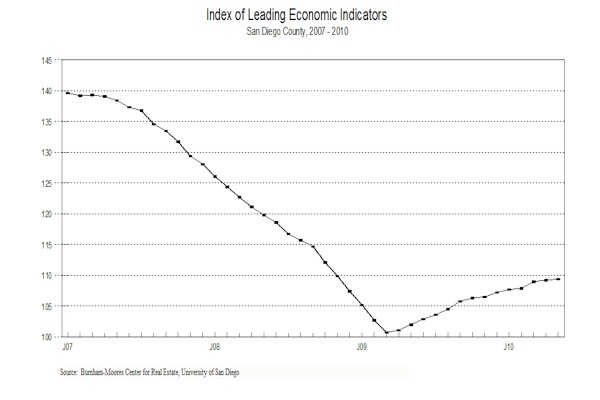|
Home
Leading Economic Indicators
Up in May
Note:
The tentative release date for next month's report is July 27.
June 30, 2010 --
The University of San Diego's Index of Leading
Economic Indicators for San Diego County rose 0.2 percent in May. The advance
was the 14th in a row for the USD Index and was led by a big surge in
building permits. There were also moderate gains in help wanted advertising and
the outlook for the national economy, as well as a minor turnaround in local
consumer confidence. On the downside, local stock prices were down sharply, and
initial claims for unemployment insurance rose, which is a negative for the
Index.
 |
Index of Leading Economic
Indicators
The index for San Diego County that includes the
components listed below (May)
Source: University of San Diego |
+ 0.2 % |
 |
Building Permits
Residential units
authorized by building permits in San Diego County (May)
Source: Construction Industry Research
Board |
+ 1.10% |
 |
Unemployment Insurance
Initial claims for unemployment insurance in San Diego County, inverted,
estimated (May)
Source: Employment Development Department |
- 0.38% |
.gif) |
Stock Prices
San Diego Stock Exchange Index (May)
Source:
San Diego Daily Transcript |
- 1.09% |
 |
Consumer Confidence
An index of consumer confidence in San
Diego County (May)
Source:
San Diego Union-Tribune |
+ 0.20% |
 |
Help Wanted Advertising
An index of online help wanted advertising in
San Diego (May)
Source: Monster Worldwide |
+ 0.81% |
 |
National Economy
Index of Leading Economic Indicators (May)
Source: The Conference Board |
+ 0.71% |
The outlook for the local economy remains
unchanged from recent months: San Diego is likely to have slow to moderate
growth for the rest of 2010 and into at least the first half of 2011. One
potential problem impacting the recovery is the fiscal problems faced by all
levels of government, particularly the huge budget deficit faced by the state of
California. Since tax increases have been ruled out, there are likely to be big
cuts in state services and employment, especially in education, which is the
biggest part of the state budget. While higher education appears to have been
spared in the budgets proposed so far, there continues to be pressure on K-12
education. Layoffs there would hurt not only in the short term due to the
reduction of consumer spending power, but the long term prospects for the local
economy could be impacted as well with a less educated workforce.
Highlights:
Residential units authorized by building permits hit their highest level
in more than a year (since March 2009) as permit activity picked up in
multi-family units. . . The labor market components continue to be mixed.
Initial claims for unemployment insurance were negative for the second month
in a row, indicating little relief in terms of job losses. It should be noted
that the initial claims data used here involve only claims filed due to job
losses as opposed to those filed as part of the extension on benefits passed by
Congress. The hiring side of the market continues to firm, with help wanted
advertising advancing for the seventh consecutive month. The net result was
that the local unemployment rate dropped to 10.0 percent in May from a rate of
10.4 percent in April. . . Local consumer confidence ended a four month
downturn with a gain in May, with the raw data for local consumer confidence
hitting its highest level since last September. . . Concerns about the strength
of the recovery in the national economy and worries about financial difficulties
internationally caused weakness in the financial markets that negatively
affected local stock prices. . . Revised data for April showed that the
national Index of Leading Economic Indicators was unchanged in the month
as opposed to the previously reported drop. That means that the national Index
has now advanced or been unchanged for 14 straight months. Despite that, there
is concern about the strength of the recovery in the national economy. The
latest evidence was the work jobs report for May, which came in with a very weak
gain of only 41,000 new private sector jobs. For now, the outlook remains
positive, but the possibility of a double dip recession remains as unemployment
remains high and consumer spending has slowed.
May’s increase puts the USD Index of Leading Economic
Indicators for San Diego County at 109.4, up from April’s reading of 109.2.
Revisions in the data for building permits, initial claims for unemployment
insurance, and the national Index of Leading Economic Indicators did not change
the Index level for April but caused the change for the month to be revised
downward to a gain of 0.1 percent instead of the previously reported gain of 0.2
percent. Please visit the Website address given below to see the revised changes
for the individual components. The values for the USD Index for the last year
are given below:

For more information on the University of San Diego's Index of Leading
Economic Indicators, please contact:
|